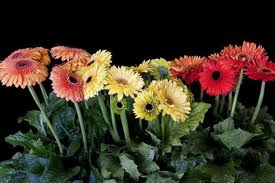Gerbera
Pot Cultivation
When they are grown in a cool greenhouse, the minimum winter temperature must be 40 degrees. Repotting should be done in April. The compost should consist of equal parts of loam, peat or leaf mold with a liberal amount of sand added. When they've been repotted, be sure to shade and lightly sprits them until they're established, after which no shading is necessary. Throughout the summer, the soil should be kept moist and applications of weak liquid fertilizer should be given once in a while. From November to May, water should be given only when the soil becomes fairly dry.Propagation
The basal shoots can be detached in April and inserted in sandy soil. Keep them in a box covered with glass until they form roots, they can then be potted in 3-inch pots and later, in the 5-inch pots in which they will bear their flowers. Seeds may also be sown in pots of sandy soil in the spring or early summer. The pots are covered with a pane of glass and when the seedlings are an inch tall they are plucked out and placed in deep pans and subsequently into separate pots. |
G. Jamesonii |




